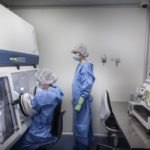
The COVID-19 pandemic has sparked extensive discussions about its effect on mental health. While global suicide rates remained stable during the pandemic, the specific impact on non-lethal suicidal behaviors, namely, ideation or suicide attempts that are survived, during and after the pandemic had not been explored.
A new study, led by Dr. Víctor Serrano-Gimeno from the Mental Health Research Group of the Sant Pau Research Institute (IR Sant Pau), reveals a significant increase in these behaviors after the lockdown. The study, published in The Lancet Psychiatry, analyzes data from a Catalan cohort from all hospitals in Catalonia collected through the Catalan Suicide Risk Code in three periods: the pre-lockdown period (January 1, 2018, until the implementation of the lockdown in Spain on March 14, 2020); the lockdown period (March 14, 2020, until the end of the lockdown on June 21, 2020); and the post-lockdown period (June 21, 2020, until December 31, 2022).
The results reveal a slight increasing trend in non-lethal suicidal behaviors from January 1, 2018, until March 13, 2020, followed by a reduction during the lockdown period and a 50.77% increase after the lockdown measures. These results highlight the prolonged impact of the pandemic on the population’s mental health. Dr. Serrano-Gimeno explains that “this study provides a comprehensive examination of non-lethal suicidal behaviors in Catalonia, highlighting the dynamics of the different phases of the COVID-19 pandemic.
The initial reduction during the strict quarantine may be explained because people have less access to methods of suicide, among other reasons. And the subsequent increase after the lockdown reflects complex factors, including social isolation and economic challenges.” Specifically, stratified data analyses indicated that the relaxation of the lockdown resulted in a significant increase in non-lethal suicidal behaviors among women – especially in the 18 to 30 age group – and among minors under 18.
These results underscore the need for preventive strategies targeted at these groups. Dr. Maria Portella, head of the Mental Health Research Group at IR Sant Pau, emphasizes the importance of this study because “it quantifies what we already suspected about mental health during the pandemic. It highlights the need for a perspective beyond mental illness to address suicidality, addressing it as a fundamental aspect of public health.”
For her, “this article highlights the much longer-term consequences of the decisions made during the pandemic. We quantify it, but it also puts a much broader focus on mental health in the sense that it wasn’t necessarily people with a psychiatric diagnosis. And this is very important because it shows that suicide is a much more global public health issue.”
In this regard, Dr. Narcís Cardoner, researcher from the Mental Health Research Group at IR Sant Pau and head of the Psychiatry Department at Sant Pau Hospital, adds that these results tell us many things that should be used to face similar situations better in the future. “It’s interesting that throughout the pandemic, physical health was markedly prioritized. And all strategies, for example, the lockdown itself, were aimed at reducing the risk of people getting infected with the virus. But we knew that the impact of these situations would go beyond. And there’s always talk of a fourth wave, which is the mental health problem. And it seems that we were somewhat oblivious to this situation. Data like those derived from this study say that physical health is very important, but there is no health without mental health, and it would have been essential to have made some provision for these impacts.”
He also emphasized that “sometimes what’s good for physical health isn’t always good for mental health. So here, looking to the future, we must propose more holistic approaches to similar situations. I think it’s an important lesson from what happened with the pandemic, especially considering that it mainly affected young women and minors. It’s a lesson whose effects we knew, we were aware of, but we were absolutely turning our backs on it. We somewhat overlooked it or denied it.”
In fact, the three experts agree that during the pandemic, other countries had more lenient lockdown measures “that seemed to not have a differentiated impact in the field of physical health, and we don’t know why because it’s true that mental health data seem to be quite generalizable worldwide.The impact of the pandemic, for example, in terms of the risk of depression, anxiety disorders, has been very marked worldwide. Rates, the prevalence of depression, and anxiety have increased. So, we’re identifying a very generalizable phenomenon.”
For them, it’s necessary that in future occasions much more global measures are considered “and to think of mental health as an essential part of health. Since the effects are not so immediate, perhaps we think they’re like second-level issues, as if they weren’t so important.”
Finally, Dr. Cardoner emphasizes the current pressure on the healthcare system: “You just have to go through our emergency rooms to see the saturation. This demonstrates that the pandemic has been a brutal stress test for an already fragile society. This study is important because it quantifies it. We all had this idea that mental health was doing terribly. And here we can confirm it with numbers. the situation has evolved as it has evolved.”
Dr. Serrano concludes that “the results show us that the consequences of large-scale social phenomena are profound, and this must be addressed from a public health perspective, not just psychiatry.”
With the collaboration of the Spanish Foundation for Science and Technology – Ministry of Science, Innovation and Universities.
![]()
Reference Article
Víctor Serrano-Gimeno, Alba Diestre, Marina Agustin-Alcain, Maria J Portella, Javier de Diego-Adeliño, Thaïs Tiana, Nora Cheddi, Alejandro Distefano, Guillermo Dominguez, Marina Arias, Victor Cardoner, Dolors Puigdemont, Victor Perez, Narcís Cardoner. Non-fatal suicide behaviours across phases in the COVID-19 pandemic: a population-based study in a Catalan cohort, The Lancet Psychiatry. Volume 11, Issue 5, 2024, Pages 348-358, ISSN 2215-0366, https://www.sciencedirect.com/science/article/abs/pii/S2215036624000658?via%3Dihub





















